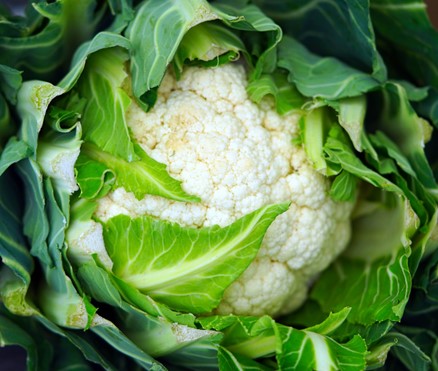- Courses: Entrée, Main Course, Side Dish
Cauliflower was first cultivated in Asia, near the Mediterranean Sea. Cauliflower has been produced and consumed in Europe since the 1500s, but it was not until the 1900s that it became popular in the United States. California now produces more cauliflower than any other state in the country. Cauliflower is farmed in California’s Salinas Valley, often known as the “Salad Bowl of the World.” Because of the mild climate and excellent soil, the growing season can continue for up to ten months. Arizona, Florida, Michigan, New York, Oregon, Texas, and Wisconsin are among the states that cultivate cauliflower.

In September and October, you can find cauliflower in farmers’ markets in Wisconsin. Cauliflower looks very similar to broccoli, with the exception of cauliflower’s white coloration. The protecting leaves that grow around the head of the cauliflower keep it white. The leaves protect the head from the sun, inhibiting chlorophyll development and preventing the head from turning green. Purple cauliflower is one of the many color variants available.
Is cauliflower a flower?

Cauliflower is a flower that has not yet fully matured. Cauliflower leaves are edible, however, they have a stronger flavor than the florets. China is the world’s leading cauliflower producer. When you cross cauliflower with broccoli, you get green cauliflower.
What are the exciting facts about cauliflower?
- Cauliflower leaves are large and coarse, with a green tint. They produce rosettes as they mature. Leaves encircle the stalk, which supports a huge, white head in the center.
- On the cross-section, Whitehead resembles a little tree. It’s made up of tightly packed curds. In giant types of cauliflower, the head is normally 6 inches across and weighs 2 to 3 pounds. A central stalk spreads out from the crown and holds undeveloped flower buds.
- The color of the head varies according to the variation. White cauliflower is the most popular, but it comes in green, purple, orange, brown, and yellow varieties.
- Cauliflower is a member of the cruciferous vegetable family. They get their name from their flowers, which have four petals and grow in the shape of a Greek cross.
- From seed to harvest, it might take anything from 50 to 265 days, depending on the cultivar. When the cauliflower has reached the desired size and texture, it is picked.
- Cauliflower is high in dietary fibers, vitamins C, K, and B vitamins, and minerals including manganese, potassium, and magnesium. Cauliflower has a low-calorie count and can be used in place of rice or potatoes.
- Raw, cooked, or pickled cauliflowers are all options.
- The bulk of vitamins is destroyed during prolonged boiling, which is linked to cauliflower’s foul, sulfur-like odor. Cauliflower’s health advantages are reduced by 75% when cooked for 30 minutes or more.
- According to medical studies, compounds derived from cauliflower can help prevent the development of some cancers.
- Cauliflower is an annual plant, which implies that it has a single life cycle.
What makes cauliflower unique?
Cauliflower has been consumed by humans for at least two thousand years and is renowned for its enormous, edible curd-like head. Broccoli, cabbage, kale, Brussels sprouts, and collard greens are all members of the same plant family as cauliflower. Each of these vegetables has been bred for certain characteristics.
What are the benefits of eating cauliflower every day?
- Cauliflower is a great source of vitamins and minerals, as it contains practically all of the vitamins and minerals your body needs.
- It is high in fiber, which is beneficial to digestive health and may minimize the risk of a variety of chronic conditions.
- It contains a high level of antioxidants, which help to reduce inflammation and protect against a variety of chronic diseases.
- It is low in calories but abundant in fiber and water, all of which could help you lose weight.
- It is high in choline, a vitamin that many individuals need. It is engaged in numerous bodily functions and helps to avoid a variety of diseases.
- Cauliflower is rich in sulforaphane, a plant compound with many beneficial effects, such as the reduced risk of cancer, heart disease, and diabetes.
- It can replace grains and legumes in many recipes, which is a great way to eat more veggies or follow a low-carb diet.
Cauliflower Wings Recipe
Both vegans and meat-eaters love these delicious crispy fried buffalo cauliflower wings. The recipe is really trendy.

Ingredients
- Ingredients:
- 1 Cauliflower
- 1 cup Unbleached White Flour
- 1 cup Cornmeal fine
- 1 1/2 cups Water
- ¼ cup Parsley
- 2 T Chicken Style or Vegetable Bouillon
- 2 T Nutritional Yeast Flakes
- 1 T Garlic Powder
- 2 tsp Baking Powder
- Salt to Taste
- Dash of Cayenne-
- 2 tsp turmeric powder
- For: 8
- Preparation: 21 min
- Cooking: 12 min
- Ready in: 33 min
Instructions
- Prep Cauliflower.
- Wash and cut the cauliflower and dry it well.
- Sprinkle cauliflower with nutritional yeast flakes and a little flour.
- Then dip them into the batter and drop them into the hot oil. Allow the cauliflower wings to cook about 2 minutes or until they are golden brown.
- Layer paper towels onto a plate and when you take the cauliflower out of the frying pan, put it onto the paper towel.
- Serve right away for the greatest texture and flavor. They will become less crispy the longer they sit. If you have any leftovers, toss them in a salad or wrap them for lunch the next day, but don't expect the breading to stay crisp.
Notes
Bottom Line
Cauliflower has a number of health benefits
It’s high in nutrients, including a few that many people require more of.
Cauliflower also includes antioxidants that may help to reduce inflammation and protect against diseases like cancer and heart disease.
Cauliflower is also simple to incorporate into your diet. It’s delicious, simple to make, and can be used to replace high-carb items in a variety of dishes.
